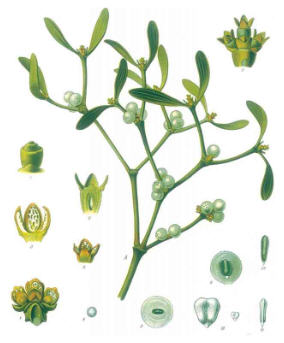Mistletoe

Mistletoe is a parasite, growing on trees such as apple, lime, poplar, hawthorn, and rowan, although some may regard the plant as a semiparasite because the leaves contain chlorophyll.
Viscum album is found throughout temperate Europe and extends into Asia. American mistletoe is Phoradendron leucarpum. All parts of the plant are toxic if eaten.
Mistletoe was regarded by the ancient Druids as a herb with magical powers. Taken internally, it is claimed that mistletoe extract lowers blood pressure, and is a tonic for the heart, an immunostimulant, an antispasmodic, a sedative, a diuretic, and has certain anticancer effects. Applied externally, it is supposed to be effective against arthritis, rheumatism, chilblains, leg ulcers, and varicose veins.
A large number of animal and human studies have looked at the efficacy of mistletoe. They have concentrated on the possible anticancer and immunostimulant properties of the plant. Much is known about the chemical constituents of mistletoe, and because the plant is a parasite it is possible that some of these are taken from the host plant and will vary according to the identity of the host.
The experiments have supported, to some extent, the anticancer and immunostimulant actions of mistletoe. Instead, there is available a commercial preparation of mistletoe for the treatment of cancer, although it is suggested that this should only be used as an adjunct to conventional practice. Viscotoxins (proteins) in the plant are regarded as the active anticancer agents.
Because of potential toxicity, mistletoe should only be used under the guidance of an experienced herbal practitioner, and should be avoided during pregnancy and lactation.

